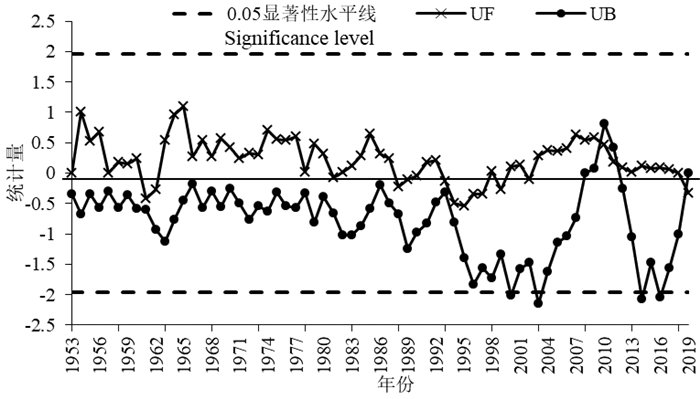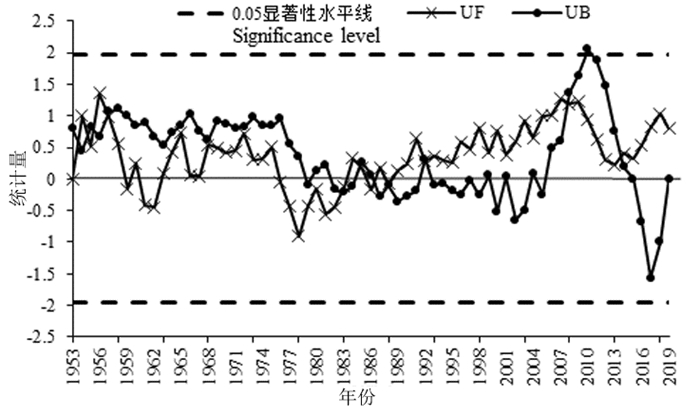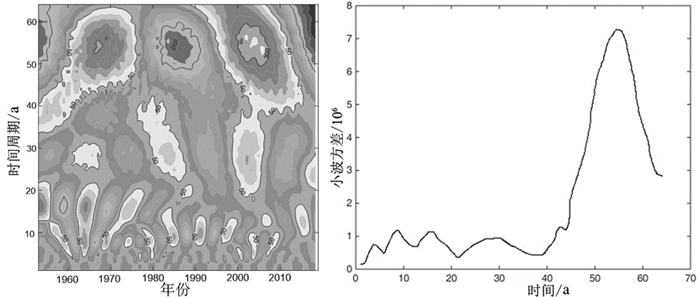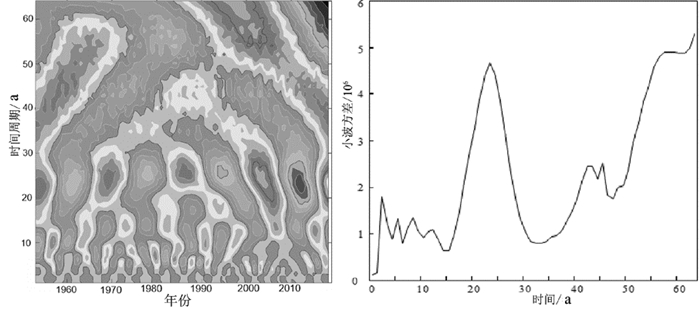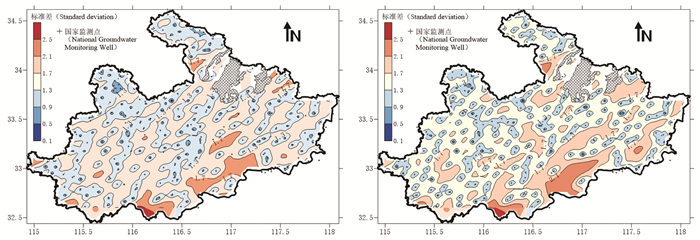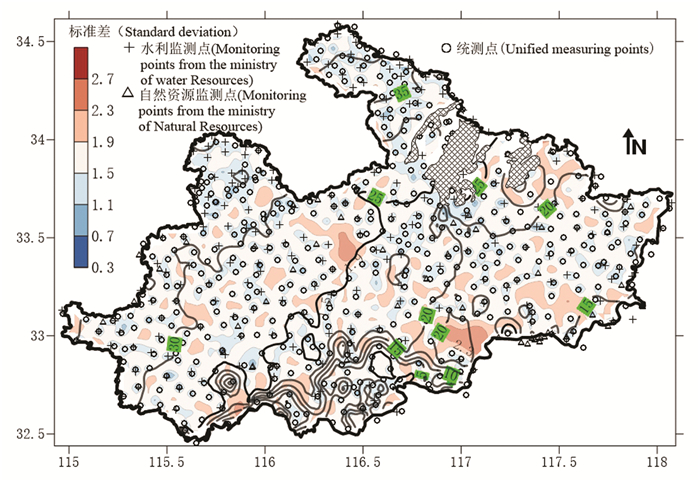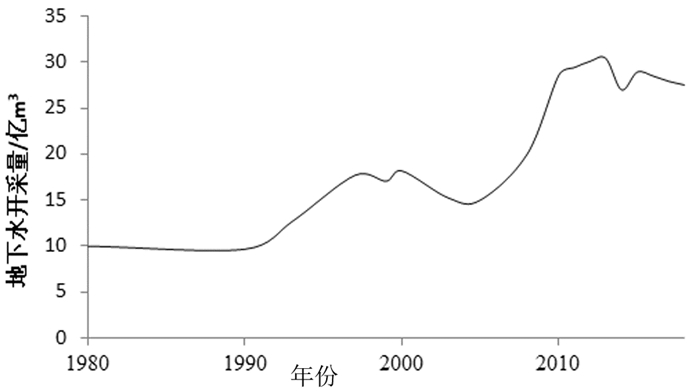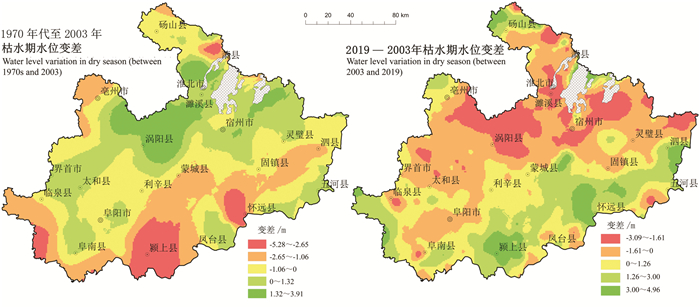Analysis of multi-year rainfall variation and shallow groundwater flow field monitoring in Huaibei Plain
-
摘要:研究目的
变化环境下地下水时空规律的研究有助于水资源精细化管理和区域水资源安全保障。
研究方法本文基于淮北平原区典型气象站1953—2019年月降雨数据,采用小波分析及M-K检验法,研究多年尺度降雨周期性变化及趋势规律;结合395个国家级监测井及地下水统测数据,采用主成分分析法进行监测井优化评价。
研究结果淮北平原多年降雨量呈现多时空尺度变化特征,南部地区主周期较北部地区偏小,但周期尺度较多,变化更为复杂;西北部的浅层地下水位持续下降,其余区域水位处于有升有降的波动状态;南部区域浅层地下水水位在1970年、2003年及2019年3个时段呈现出先降低再恢复,北部部分区域地下水水位则呈现先升高再降低的特征,研究区水位总体存在下降趋势,但2000年以来水位总体有所回升;经主成分分析优化后的277个监测井(221个水利井和56个自然资源井)能代表395个原国家监测井的总体水位变化情况。
结论国家地下水监测工程长序列监测数据能够很好地服务于流域尺度水资源评价及管理,但省市级尺度或重点区域还需要进行优化和加密,地下水位统测可有效填补,该工作应在重要河湖两侧、淮河北岸一带、东北部山前平原等高水力梯度区域进行加密。
创新点:(1)采用多种统计检验方法,研究淮北平原地下水流场演变特征及影响因素;(2)本文提供了一种监测网的评估和优化方法,以淮北平原为例,评估了监测-统测网的效能,并提出了优化建议。
Abstract:This paper is the result of groundwater survey engineering.
ObjectiveThe study on the temporal and spatial law of groundwater under changing environment is helpful to the fine management of water resources and the guarantee for regional water resources security.
MethodsBased on the rainfall data of typical weather stations in the Huaibei Plain from 1953 to 2019, the wavelet analysis and M-K test method was used to study the periodic changes and trend of rainfall on a multi-year scale. Combined with 395 national monitoring wells and groundwater monitoring data, the principal components analytical method was used to optimize the evaluation of monitoring wells.
ResultsThe results show that the rainfall in Huaibei Plain appears multiple temporal and spatial scales variation characteristics: The shallow groundwater level has declined continuously in the northwest, while fluctuated greatly in the other regions; In 1970, 2003 and 2019, the shallow groundwater level in the southern region decreased firstly and then recovered, and on the contrast, the shallow groundwater level in the northern region increased firstly and then decreased; The groundwater level in the study area has generally declined; And since 2000, the water level has somewhat risen; The 277 monitoring wells (221 water wells and 56 natural resource wells) optimized by principal component analysis can represent the overall water level changes of 395 original national monitoring wells.
ConclusionsThe long-term monitoring data of the national groundwater monitoring project can well serve the evaluation and management of water resources at the basin scale, but still need to be optimized and densified at the provincial, municipal scales or key areas. The artificial observation in unified time period can also make up for this deficiency which should be densified in the high hydraulic gradient areas such as both sides of important rivers and lakes, the north bank of Huaihe River, and the piedmont plain in the northeast.
-
1. 引言
安徽省淮北平原地处黄淮海平原南侧,自然条件较为优越,适合“两高一优”(高产、高效、优质)农业综合开发利用,是中国重要商品粮生产基地之一,农业发展前景广阔,同时其人均的水资源量不足全国人均水资源量的1/4,是水资源供需严重不足的地区。境内河流主要为淮河的支流,有谷河、润河、颍河、西淝河、茨河、涡河、北淝河、沱河等,集水面积大,流程长,坡降小,流速缓,易发生洪水灾害。较大的湖泊主要有老汪湖、焦岗湖、八里湖、化家湖、四方湖等。
淮北平原地下水开采历史悠久,自20世纪70年代末以来,浅部地下水开采量急剧增长,地下水超采问题不断加剧,造成了诸多环境地质问题:地下水位持续下降、地面沉降、水质劣化、地表渠系干涸等(龚建师等, 2021)。近年来政府逐步重视农村安全饮水问题,城乡居民分散开采浅层地下水逐渐减少,向乡镇中深层集中开采转移,这也导致了浅层地下水位稳中有升,中深层地下水位持续下降,目前浅层地下水开采量维持在20亿m3左右,主要为农业用水。
随着气候变化和人类活动加剧导致的水循环条件改变,加剧了区域乃至全球范围内水资源时空分布不均,以及极端气象水文事件的频繁发生。水资源供需矛盾加剧导致了人们大量开采地下水资源,地下水位埋深不断增大,由此引发的环境地质问题极大制约着流域社会经济可持续发展(姚蕊等, 2020),因此研究变化条件下的地下水时空变化及监测网优化对区域的水资源利用和保障问题有着重要的意义,可为新时期生态文明约束下地下水超采治理、地下水资源可持续利用和生态环境保护提供科学依据。
在地下水水位时空演变特征方面,国外一般是借助地统计学的方法利用地理信息系统进行研究(Machiwal et al., 2012; Júnez-Ferreira et al., 2019),系列数据时间演变常借助时间序列分析法,包含Mann-Kendall检验法、小波分析、混沌理论、频谱分析等(Gocic and Trajkovic, 2013; 王豪杰等, 2017; Wang et al., 2018;Sun et al., 2020),国内学者对淮北平原地下水问题也开展过相关研究,如对淮北平原降雨量进行长时间序列研究(尚晓三等, 2014),对淮北地区地下水位埋深的年内、年际动态变化特征的研究及预测(王发信和柏菊, 2014; 陈玺等, 2016; 陈笑,2019; 姚蕊等, 2020),以寻找地下水位变化的影响因素和时空规律。在地下水监测网研究方面,一般使用地质统计学考虑气象、水文地质、地貌等背景条件(Ahmadian and Chavoshian, 2012;Janardhanan et al., 2020),采用克里金插值(刘治政等, 2010),结合地面沉降、地下水动态类型等因素以插值误差的方差作为精度评价(雷坤超等, 2016; 崔霖峰等, 2019),进行监测点的布设及优化。Ahmed et al. (2020)在巴基斯坦印度河下游盆地,利用建模方法与地统计学分析相结合,采用主成分分析(PCA)对监测网进行了缩减和优化,而国内鲜有采用PCA方法进行监测网的评估工作,且国家地下水监测工程实施以来,其数据精度及监测网效能在淮北平原也未见相应评估。
本文根据近年来实施的国家监测工程和主要平原盆地地下水统测工作,结合笔者所承担的沙颍河-涡河流域水文地质调查项目,首先采用小波分析及M-K检验法对区域降雨进行周期和趋势研究,对水动力条件变化及其主要影响因素进行系统分析,然后对区域下垫面变化进行遥感解译分析,在此基础上采用PCA法评估现有国家监测网长序列监测数据效能,最后开展监测网优化研究及地下水统测建议。
2. 研究区概况
安徽省淮北平原是指淮河以北境域,位于东经114°45′~118°15′,北纬32°20′~34°40′,地处淮河流域中游,面积3.77万km2,是中国重要的煤炭基地和粮食基地。淮北平原处于中国东部地区南北气候的分界线,气候类型为暖温带半湿润半于旱气候,年降水量600~1400 mm,由南向北递减,年际、年内分布极不均匀,年径流系数0.1~0.6。
安徽省淮北平原属黄淮海大平原的南缘,西、北、东分别与豫东平原和苏北平原接壤,南邻江淮波状平原(图 1)。北部由于全新世晚期黄河南泛、改道的影响,接受了最新的全新世沉积,成为现代黄河冲积扇的前缘部分,南部基本未受黄泛波及,主要为晚更新世粉质黏土组成的剥蚀平原。淮北平原东北部的低山、丘陵,海拔80~400 m,主要由新元古代和古生代的碳酸盐岩夹碎屑岩以及部分侵入岩岩脉组成。
区内的浅层地下水主要由第四纪全新世沉积的粉砂、细砂、粉土等组成,埋深小于50 m,直接接受大气降水的补给,参与现代水循环,季节性变化明显(图 2)。淮北平原区土层具有垂直渗透强、水平渗透弱的特点,因此天然条件下,浅层地下水形成、分布、埋藏及其运移规律以垂向补给消耗为主,水位动态属渗入蒸发型,主要补给方式为降水入渗,次为汛期河流和蓄水工程入渗、灌溉回渗及上游(区外)地下径流来水等。地下水位埋深的时空变化规律主要受到降水、地表径流和开采等共同影响,降水起决定性作用。一年中一般出现两个水位峰值,梅雨期为小峰(春潮),6—9月汛期为大峰(夏讯)。地下水位变化略滞后于降水,丰水期地下水位在有效降水后1~2 d后上升明显,枯水期,滞后时间可达4~6 d。
3. 研究方法及数据来源
3.1 M-K检验
利用Mann-Kendall趋势检验法分析降雨量的突变特征。通过计算时间序列数据的标准化变量UF,与某一置信水平α(取0.05)下的临界变量对比。当UF为正表示有上升趋势,为负则表示有下降趋势;当UF超出临界值时表明上升或下降趋势显著(郭文献等, 2019)。本文采用M-K趋势检验法研究主要气象因子的变化特征,揭示降雨量长时间尺度的趋势变化。
3.2 小波分析
小波分析的基本思想是一簇小波函数系来表示或逼近某一信号或函数,小波函数是指具有震荡性、能够迅速衰减到零的一类函数,即小波函数。小波函数源于多分辨分析(多尺度分析),其基本思想是将扩中的函数f(t)表示为一系列逐次逼近表达式,其中每一个都是f(t)动经过平滑后的形式,它们分别对应不同的分辨率(多尺度)。
在水文分析中,小波分析主要应用于水文过程的多时间尺度和周期变化分析,能客观定量地得出数据序列中隐藏的多种周期性变化,并可以对数据序列局部进行细化分析,以得出长序列内部的周期变化规律。本文采用小波分析进行降雨量的周期性规律研究。
3.3 主成分分析(PCA)
主成分分析是一种常用的基于变量协方差矩阵对信息进行处理、压缩和提取的有效方法,用于识别解释系统大部分方差的重要成分或因素。此技术已扩展到评估地下水动态的监测网络中,目的是根据水位观测值对监测井的重要性进行排序,基于现状监测网,从经济的角度筛选或去除那些相对不重要的监测井。本文采用PCA法对国家地下水监测网进行排序评估,结合克里金法进一步优化监测统测网。
3.4 克里金(Kriging)法
Kriging方法是一种对时空分布变量求最优、线性、无偏内插估计量的方法。根据已知监测井的实测数据,对其进行结构性分析(变差函数的确定)之后,对周围已知井的测量值赋予一定的权系数,进行加权平均来估计待估点数值。本文采用Kriging法对优化前后的国家监测网及水位统测数据进行标准差评估。
3.5 数据来源
本文1953—2018年气象数据来源为国家气象网下载及淮委搜集,为对比南北差异,选取亳州和阜阳两个代表站。20世纪70年代及2003年地下水位来源于安徽地质调查院积累的监测数据,2019年和2020年枯水期地下水位统测数据来源于中国地质调查局南京地质调查中心实测数据。
4. 结果分析
4.1 淮北平原降雨的多年变化
4.1.1 趋势线分析
降水入渗补给是地下水的主要来源,降水量变化对地下水位变化有显著的影响。运用趋势线分析区内亳州和阜阳地区气象站降雨量的变化情况(图 3)。
由图 3可知,淮北平原亳州站年降水量在研究期内总体呈下降趋势,平均线性递减率为0.60 mm/a。降雨量年际分布不均匀,年平均最大值为1472.1 mm,最小值仅472.7 mm,降雨量极端值出现频繁。淮北平原阜阳站年降水量在研究期内总体呈上升趋势,平均线性递增率为1.20 mm/a,降雨量年际分布不均匀,年平均最大值为1618.2 mm,最小值仅438.0 mm。两站对比而言,淮北平原南部降雨量波动较北部大,丰枯交替更为频繁。
4.1.2 M-K秩次相关检验分析
根据图 4可知,亳州站降雨量呈上升—下降—上升—下降—上升趋势,2009年、2012年和2019年降雨量发生突变(UF和UB交点),均与安徽淮北地区干旱年份相对应。根据图 5,阜阳站降雨量也总体呈上升—下降—上升—下降—上升趋势,2个站点均未超出显著性水平,说明变化趋势并不十分明显,阜阳站UF和UB两条曲线在1953—1958年、1983—1993年、2007—2013年期间产生了多个交点,相比较而言,阜阳地区比亳州地区降雨量变化更为复杂,丰枯交替更为频繁。伴随气候变暖及季风的双重影响,淮北平原水循环形式将发生变化,进一步加剧了降水时空分布的差异性。
4.1.3 小波分析
从图 6可以看出,亳州地区降水量从上至下存在着50~60 a,26~31 a,15~18 a,7~10 a四类尺度的周期变化规律,且各尺度的周期变化波动性明显。从尺度较大的50~60 a分析来看,降水量经历了3次丰枯交替。小波方差图中出现了5个峰值,说明降水量变化的主周期分别是54 a、28 a、17 a、8 a、3 a,其中以54 a为第一主周期的变化最为显著。
从图 7阜阳监测点降水量小波等直线图可以看出,降水量从上至下存在着55~60 a,41~45 a,20~30 a, 10~15 a,5~7 a五类尺度的周期变化规律,且各尺度的周期变化波动性明显。从尺度较大的20~30 a分析来看,降水量经历了9次丰枯交替。小波方差图中出现了5个相对明显的峰值,说明降雨变化的主周期分别是54 a、44 a、25 a、12 a、3 a,其中以25 a为第一主周期的变化最为显著,而在64 a之后可能存在另一个比较明显的主周期。
淮北平原地区年降雨量呈现多时间尺度特征,南部地区主周期较北部地区偏小,但周期尺度较多,变化更为复杂。
4.2 土地利用长时序变化
土地利用等下垫面的变化,会引发地下水位的响应(姜月华等, 2017; Song et al., 2021),如建筑用地的增加可明显减少降水的入渗,导致地下水得不到补给,耕地的增加可导致地下水开采灌溉,引发地下水位降低。基于Landsat-8卫星影像资料,采用人机交互、面向对象的分类方法对淮北平原区2018年土地利用类型进行遥感解译。收集1980年、2000年土地利用分类数据,结合GIS空间分析技术进行1980年、2000年和2018年的土地利用类型变化分析,研究不同类型的转移规律。
淮北平原1980—2000年间,耕地减少418 km2,水域及水利设施面积增加111 km2,建设用地面积增加302 km2,其他类型面积变化不大;其中386 km2耕地转为建设用地,50 km2耕地转为水域用地,75 km2建设用地转为水域及水利设施用地,总体上导致了降水入渗地下水量减少,一定程度上引发了地下水水位下降。2000—2018年,耕地面积减少4524 km2,林地增加4584 km2,草地减少35 km2,水域及水利设施增加305 km2;其中减少的耕地面积主要转为建设用地,其次转为水域及草地,林地的增加主要来自于耕地、建设用地及水域,草地主要转为耕地和建设用地,水域及设施用地主要转为耕地、建设用地(图 8)。
总体而言,随着城镇化进程的加速,淮北平原近40年来耕地面积持续减少,建设用地持续增加,淮北平原开始向第二产业第三产业转移,这导致了浅层地下水农业开采强度减弱,城市深层地下水开采增强;随着21世纪初国家退耕还林政策的实施,林地面积增加,草地占比略微下降,城镇化进展加速的同时,也更注重生态环境的保护,致使水域及水利设施用地面积增加,这导致了土壤水源涵养能力增加,一定程度上改变了区域水文循环过程。
4.3 主成分分析
根据搜集到监测井2018年1月—2020年8月共32个月的平均水位值,用于研究区域395个国家监测井的进一步优先次序。监测井被认为是可变的(列),时间水位值被视为观测值(行)。因为主成分分析识别记录数据变化最大的轴,这些轴称为主成分且彼此正交。第一分量记录数据的最大方差,第二分量记录剩余数据中的最大方差等,主成分的总数小于等于变量的数量。本文中应用PCA的目的是确定最能代表总体地下水水头差异的监测井的位置,从而评估目前监测网数量及分布的合理性。然后应用方差极大正交旋转来进一步减少代表孔,这最大化了平方载荷的方差之和,并保留了变量的不变性。方差极大旋转后的应用进一步优化了主要组件,这在结果中变得很明显。在本文中,为去除数据中的相关性,选择因子荷载矩阵分数等于或大于0.85的井作为优先,该阈值仅保留了地下水头波动较高的井。
国家地下水监测工程建设单位已实施了数据共享,但仍分属不同部门,水利部门和自然资源部门在监测层位、监测目的方面不尽相同、互为补充,各有目的和侧重,因此对区内水利监测井和自然资源监测井分别进行主成分分析。其中247个水利井在前两个主成分中,共有237个井是最佳的,并且这2个分量解释了96.75%的方差,在进行正交旋转后,前2个主成分解释了基本相同的方差量,但有221个最佳井。结果表明,这221口井能够较好地代表现有水利监测井的总体水头变化,平均误差为0.38 m(表 1)。
表 1 水利监测井主成分分析结果统计(m)Table 1. The principal component analysis results of monitoring wells from Water Sector(m)
148个自然资源监测井在前5个主成分中,共有72个井是最佳的,这5个分量解释了80.83%的方差,在进行正交旋转后,前5个主成分解释了基本相同的方差量,但有56个井是最佳的。结果表明,这56口井能够代表现有自然资源监测井的总体水头变化,平均误差为0.57 m(表 2)。
表 2 自然资源监测井主成分分析结果统计(m)Table 2. The principal component analysis results of monitoring wells from Natural resources department(m)
经主成分分析后的277个优化井(221个水利井和56个自然资源井)能代表395个原国家监测井的总体水位变化情况,但该方法仅是针对现有井孔观测数据本身的分析,不能反应监测井在整个空间范围的分布。因此仍然需要考虑监测井的位置,进行合理布设和调整。
4.4 水位分区
计算优选前后国家监测井数据的32个月水位平均值,采用克里金插值法,进行水位分区。优选前395个国家监测点,最小水位值为3.21 m,最大水头值为44.42 m,标准偏差为2.75。优选后277个国家监测点,最小水位值为11.95 m,最大水头值为44.42 m,标准偏差为2.69,基本能代表原监测点的平均水位数据。从图 9可以看出,优化后区域北部整体标准偏差减小,南部淮河沿线标准偏差增大,这是由于该位置的地下水水力梯度增大,从而形成块金效应。东部山前平原区,标准偏差增大,是因为主成分分析去除了该区域水位较低的井,导致误差增大。
2020年5—6月期间开展了462个浅层地下水统测点,联合277个国家监测点,形成了淮北平原2020年枯水期地下水位研究(图 10)。水位平均值26.47 m,标准偏差2.64 m,标准误差0.27 m,整体上北部偏差比南部小。统测点联合国家监测点,能更好的刻画地下水流场特征,实现地下水位、水量的精细研究。但从图中可以看出,南部水力梯度较大,应在淮河北岸一带多布置相应工作量;东部山前平原也是浅层地下水水位的变化区,也适当加密统测点密度;湖泊及河流附近,标准差偏大,可应适当加密。
5. 讨论与建议
5.1 地下水动态变化
20世纪70年代中期以前,淮北平原地下水开发利用较少。之后,特别是80年代以来,随着经济社会的高速发展,地下水的需求量越来越大,开采量逐年增加。1980—1990年,淮北平原地下水资源开发利用情况基本不变;1990—1999年,随着工业发展,开采量增加了近1倍。1999—2013年,城市化进程加快,各地水厂以及农村分散式水源地陆续建成,地下水开采迅速增长(中深层地下水为主要增长量),至2013年地下水开采量达到最大值。2013年以后,随着城市集中开采水源地的建成以及农村安全饮用水工程的基本覆盖,地下水开采量趋于稳定。近些年,随着阜阳、亳州等地区地下水的限采与超采治理,地下水开采量稍有减少(主要为中深层地下水),浅部孔隙水开采量近年来比较稳定,见图 11及表 3所示。
表 3 2018年淮北平原主要地(市)地下水开采量Table 3. Groundwater exploitation in major cities of Huaibei Plain in 2018
淮北平原浅层地下水动态类型自20世纪90年代开始转化为入渗-蒸发-开采型,地下水位埋深除主要受降雨控制外,还受到蒸发、人工开采等因素的制约。农业是浅层地下水开采的主要用途,3—5月是冬小麦的生长发育关键期,也是作物需水量最大时期,8—9月是大豆、玉米生长关键期,该时期降水呈减小趋势,大部分地区需要开采地下水进行灌溉。位于河流附近的局部地区,可以引河水进行灌溉,附近地下水位的抬升主要是农作物灌溉水入渗补充。但降雨仍然是控制浅层地下水的主要因素。
5.2 水位多年变化
淮北平原20世纪70年代、2003年和2019年地下水等水位线分布总体基本一致,从年际来看,地下水流场总体并未发生明显改变,但局部地区受降雨、开采等因素控制,出现偏移。对比3个年代枯水期地下水位变化(图 12),地下水位埋深70年代较浅,平均水位26.89 m;2003年左右地下水位埋深最大,平均水位25.66 m,整体较70年代减少了1.23 m,其中南部颍上县、怀远县一带下降较多,北部的涡阳县、宿州市、淮北市一带出现了不同程度的水位上升,对比降雨量发现水位上升区枯水期降雨较其他区域偏多,地下水开采相应减少;随后地下水位有整体回升趋势,但最低地下水水位呈扩大趋势,2019年枯水期地下水水位平均25.94 m,上升约0.28 m,其中南部颍上县、怀远县、五河县及北边界砀山出现较大幅度回升,北部涡阳、宿州一带出现不同程度下降,对比降雨量发现水位下降区降雨较其他区域偏少,地下水开采相应增大。总体上,淮北平原南部区域地下水水位呈现出先降低再恢复,北部部分区域地下水水位呈现先升高再降低的特征,主要原因是南北降雨量的不同周期及趋势变化,另外是由于降雨量会引发地下水开采的增大或者减少,对水位变化形成放大效应。就水位埋深而言,南部地区地下水水位埋深总体小于北部地区,东北部的地下水位埋深最大,夏季地下水位埋深平均最小,春季最大,其次是秋季和冬季。
据2020年低水位期与2019年同期浅层孔隙水水位统测结果比较,2020年浅层孔隙水水位埋深下降趋势明显,淮北平原大部分地区均出现了不同程度的水位下降,下降幅度在0~2 m,在淮北平原北部萧县杨楼镇,淮北平原西北部古井镇、双沟镇、皮条孙镇,淮北平原南部的魏庄镇—新马桥镇一带水位埋深下降超过2 m,但总体下降幅度都在4 m以内。仅在颍上县江口镇—展沟镇—岳张集镇一带、阜阳市区至袁寨镇、临泉县、泗县草沟镇、宿州市城区出现了小范围的水位上升区,水位上升幅度一般不超过2 m。浅层地下水水位的大面积下降是由于2019年下半年持续的干旱,浅层地下水的蒸发及农田灌溉开发利用量增加所致。
6. 结论
(1) 淮北平原年降雨量呈现多时空尺度变化特征,具有明显的周期性,南部地区主周期较北部地区偏小,但周期尺度较多,变化更为复杂。
(2) 淮北平原下垫面的变化,如耕地减少、建设用地增加、林地增加、水域增加等,改变了地表水文及地下水循环特征;城镇化加速、退耕还林、生态文明建设等政策导向下的人类活动使得地下水动态呈现出复杂特征,迫切需要高频率、高密度及高质量的地下水位监测工作。
(3) 地下水位统测能够提高监测网点的密度,联合国家地下水监测网数据,可精细刻画某一时段地下水流场特征,淮北平原地下水统测应在重要河湖两侧、淮河北岸一带、东北部山前平原等高水力梯度区域进行加密。
(4) 国家地下水监测工程是信息化社会对地下水监测工作的高度凝结,水利、自然资源及生态环境三部门应当共享合作、各取所需,结合各自职能进一步优化地下水监测点位布局。本文也提供了一种评估和优化方法,即采用PCA评价现有监测网精度,剔除数据冗余,在低密度区进行水位统测补充或者建立新的地下水监测井,使获得的数据高效精炼。
-
表 1 水利监测井主成分分析结果统计(m)
Table 1 The principal component analysis results of monitoring wells from Water Sector(m)

表 2 自然资源监测井主成分分析结果统计(m)
Table 2 The principal component analysis results of monitoring wells from Natural resources department(m)

表 3 2018年淮北平原主要地(市)地下水开采量
Table 3 Groundwater exploitation in major cities of Huaibei Plain in 2018

-
Ahmadian M, Chavoshian M. 2012. Spatial variability zonation of groundwater-table by use geo-statistical methods in central region of Hamadan province[J]. Journal of Annals of Biological Research, 3(11): 5304-5312.
Ahmed Waqas, Zulfiqar Ali Rahimoon, Carlos Anthony Oroza, Salman Sarwar, Abdul Latif Qureshi, Jehangir Framroze Punthakey, Muhammad Arfan. 2020. Modelling groundwater hydraulics to design a groundwater level monitoring network for sustainable management of fresh groundwater Lensin Lower Indus Basin, Pakistan[J]. Applied Sciences, 10(15): 5200. https://doi.org/10.3390/app10155200
Chen X, Hao Z C, Dai M L. 2016. Danimic analysis of shallow groundwater in Huaibei Plain[J]. Journal of Anhui Agriculture Science, 44(28): 73-76(in Chinese with English abstract).
Chen Xiao. 2019. Study on Evolution and Prediction of Groundwater Depth in Huaibei Plain of Anhui Province[D]. Hefei: Anhui Agricultural University (in Chinese with English abstract).
Cui Linfeng, Yang Xue, Chen Bangsong, Li Haitao. 2019. Optimum design of regional groundwater level monitoring networks in Wuhan[J]. Ground Water, 41(4): 33-36(in Chinese with English abstract).
Gocic M, Trajkovic S. 2013. Analysis of changes in meteorological variables using Mann-Kendall and Sen's slope estimator statistical tests in Serbia[J]. Global & Planetary Change, 100(1): 172-182.
Gong Jianshi, Wang Hesheng, Li Liang, Zhou Kai'e, Ye Yonghong, Zhu Chunfang, Xu Naizhen, Tao Xiaohu, Tan Mengjiao, Shu Longcang, Zhao Guizhang. 2021. Groundwater resources and development potential in Huaihe River Basin[J]. Geology in China, 48(4): 1052-1061(in Chinese with English abstract).
Guo Wenxian, Li Yue, Zhang Ling, Zhao Rongsheng, Wang Hongxiang. 2019. Analysis of annual runoff and sediment variation and driving factors at Yichang Station in Yangtze River over 60 years[J]. Journal of China Hydrology, 39(6): 69-73(in Chinese with English abstract).
Janardhanan Sreekanth, Dan Gladish, Dennis Gonzalez, Dan Pagendam, Trevor Pickett, Tao Cui. 2020. Optimal design and prediction-independent verification of groundwater monitoring network[J]. Water, 12(1): 123. https://doi.org/10.3390/w12010123
Jiang Yuehua, Lin Liangjun, Chen Lide, Ni Huayong, Ge Weiya, Cheng Hangxin, Zhai Gangyi, Wang Guiling, Ban Yizhong, Li Yuan, Lei Mingtang, Tan Chengxuan, Su Jingwen, Zhou Quanping, Zhang Taili, Li Yun, Liu Hongying, Peng Ke, Wang Hanmei. 2017. Research on conditions of resources and environment and major geological problems in the Yangtze River Economic Zone[J]. Geology in China, 44(6): 1045-1061. (in Chinese with English abstract).
Júnez-Ferreira H E, Herrera G S, Saucedo E, Pacheco-Guerrero A, 2019. A. Pacheco-Guerrero. Influence of available data on the geostatistical-based design of optimal spatiotemporal groundwater-level-monitoring networks[J]. Hydrogeology Journal, 27: 1207-1227. doi: 10.1007/s10040-018-01921-w
Lei Kunchao, Luo Yong, Chen Beibei, Guo Gaoxuan, Jia Sanman, Tian Fang, Zhou Yi. 2016. Optimization design of land subsidence levelling network of Beijing Plain[J]. Geology in China, 43(4): 1457-1467(in Chinese with English abstract).
Liu Zhizheng, Wu Xiaodong, Lin Hongxiao. 2010. Kriging interpolation model and its application in optimization of groundwater level monitoring network[J]. Yangtae River, 41(9): 14-17(in Chinese with English abstract).
Machiwal Deepesh, Mishra Amit, Jha Madan K, Sharma Arun, Sisodia S S. 2012. Modeling short-term spatial and temporal variability of groundwater level using geostatistics and GIS[J]. Journal of Natural Resource Research, 21(1): 117-136. doi: 10.1007/s11053-011-9167-8
Song Ge, Huang Jinting, Ning Bohan, Wang Jiawei, Zeng Lei. 2021. Effects of groundwater level on vegetation in the arid area of western China[J]. China Geology, 4(3): 527-535.
Sun Fangqiang, Yin Lihe, Jia Wuhui, Zhang Jun, Wang Xiaoyong, Zhu Lifeng, Zhang Xinxin, Tang Xiaoping, Dong Jiaqiu. 2020. Soil water movement and deep drainage through thick vadose zones on the northern slope of the Tianshan Mountain: Croplands vs. natural lands[J]. China Geology, 3(1): 113-123. doi: 10.31035/cg2020008
Wang Faxin, Bai Ju. 2014. Distribution characteristics of shallow groundwater depth in huaibei plain[J]. Ground Water, 36(5): 51-53(in Chinese with English abstract).
Wang Guiling, Zhang Wei, Ma Feng, Lin Wenjing, Liang Jiyun, Zhu Xi. 2018. Overview on hydrothermal and hot dry rock researches in China[J]. China Geology, 1(2): 273-285. doi: 10.31035/cg2018021
Wang Haojie, Zuo Qiting, Luo ZengLiang. 2017. Runoff evolution characteristics of a typical station in Shayinghe River basin and attribution analysis[J]. South to North Water Transfers and Water Science & Tenchnology, 15(5): 36-42(in Chinese with English abstract).
Yao Rui, Sun Peng, Zhang Qiang, Jiang Shangming, Xia Min, Wang Hongjun. 2020. Spatiotemporal patterns of the shallow groundwater depth across the Huaibei Plain[J]. Acta Scientiarum Naturalium Universitatis Sunyatseni, 59(2): 110-119(in Chinese with English abstract).
陈玺, 郝振纯, 戴明龙. 2016. 淮北平原浅层地下水动态研究[J]. 安徽农业科学, 44(28): 73-76. https://www.cnki.com.cn/Article/CJFDTOTAL-AHNY201628024.htm 陈笑. 2019. 安徽省淮北平原地下水位埋深演变及预测研究[D]. 合肥: 安徽农业大学. 崔霖峰, 杨雪, 陈邦松, 李海涛. 2019. 武汉市区域地下水位监测网优化研究[J]. 地下水, 44(4): 33-36. https://www.cnki.com.cn/Article/CJFDTOTAL-DXSU201904012.htm 龚建师, 王赫生, 李亮, 周锴锷, 叶永红, 朱春芳, 徐乃政, 陶小虎, 檀梦皎, 束龙仓, 赵贵章. 2021. 淮河流域地下水资源概况及开发潜力[J]. 中国地质, 48(4): 1052-1061. http://geochina.cgs.gov.cn/geochina/article/abstract/20210405?st=search 郭文献, 李越, 张陵, 赵荣生, 王鸿翔. 2019. 近60年长江中游宜昌站水沙变化与驱动因素分析[J]. 水文, 39(6): 69-73, 58. https://www.cnki.com.cn/Article/CJFDTOTAL-SWZZ201906012.htm 姜月华, 林良俊, 陈立德, 倪化勇, 葛伟亚, 成杭新, 翟刚毅, 王贵玲, 班宜忠, 李媛, 雷明堂, 谭成轩, 苏晶文, 周权平, 张泰丽, 李云, 刘红樱, 彭柯, 王寒梅. 2017. 长江经济带资源环境条件与重大地质问题[J]. 中国地质, 44(6): 1045-1061. http://geochina.cgs.gov.cn/geochina/article/abstract/20170601?st=search 雷坤超, 罗勇, 陈蓓蓓, 郭高轩, 贾三满, 田芳, 周毅. 2016. 北京平原区地面沉降水准监测网点位优化[J]. 中国地质, 43(4): 1457-1467. http://geochina.cgs.gov.cn/geochina/article/abstract/20160429?st=search 刘治政, 吴晓东, 林洪孝. 2010. Kriging插值模型在地下水位监测网优化中的应用[J]. 人民长江, 41(9): 14-17. https://www.cnki.com.cn/Article/CJFDTOTAL-RIVE201009005.htm 王发信, 柏菊. 2014. 淮北平原浅层地下水位埋深区域分布特点[J]. 地下水, 36(5): 51-53. 王豪杰, 左其亭, 罗增良. 2017. 沙颍河代表站径流演变特征及归因分析[J]. 南水北调与水利科技, 15(5): 36-42. https://www.cnki.com.cn/Article/CJFDTOTAL-NSBD201705006.htm 姚蕊, 孙鹏, 张强, 蒋尚明, 夏敏, 汪军红. 2020. 淮北平原区浅层地下水埋深时空分布特征[J]. 中山大学学报(自然科学版), 59(2): 110-119. https://www.cnki.com.cn/Article/CJFDTOTAL-ZSDZ202002013.htm -
期刊类型引用(2)
1. 王禹. 安徽省淮北市多年降雨变化及浅层地下水位响应研究. 江淮水利科技. 2024(02): 32-37 .  百度学术
百度学术
2. 曹先树,王浩,吴晨晨,曹炎煦,顾雨田. 淮河流域及山东半岛地下水超采原因与管理对策. 水利水电科技进展. 2024(05): 65-73 .  百度学术
百度学术
其他类型引用(1)



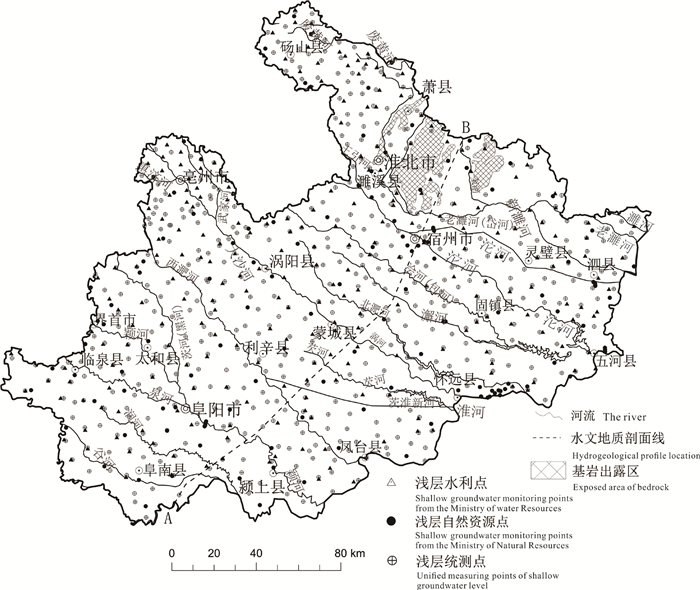
 下载:
下载:


